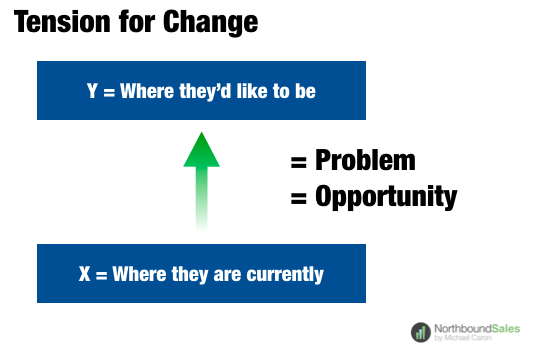The use of scale questions will help uncover more sales opportunities.
We all know that good questions are the most powerful tool in sales. But some are markedly better than others. One of the most powerful types is the scale question. What’s a scale question? (Good question!) A scale question is one that asks your buyer to answer on a scale, usually from 1 to 10.
To understand why they are so helpful in sales, we need to take a step back. Solutions, by definition, can only exist if there is a problem. Although many companies claim they sell “X solutions” it’s often not possible because their salespeople haven’t uncovered legitimate problems from the potential buyer that their solution can solve. It’s the dreaded trap of “a solution in search of a problem.”
Needs begin with problems and problems only exist when their is a gap between where someone is currently and where they’d like to be. This is commonly called the “tension for change.” Some might have an issue referring to this “tension for change” or gap as a problem. They might prefer to call it an opportunity instead. It really doesn’t matter what you choose to call it, however. What’s important is that we realize that without a gap, there is no possibility for a sale. The potential buyer sees no reason to change from the status quo. On the other hand, the bigger the gap, the more motivated a buyer will be to find a solution.
During the discovery phase of a sale, a good strategy is to establish what the key result areas are for the customer and then uncover the level of satisfaction in these areas. Here’s an example of a simple way to do this.
You: “John, could you share with me the 3 or 4 most important criteria to you in choosing a (your industry) partner?
Prospect: “Price is most important.”
You: “OK. And besides price, what would be next important?”
Prospect: “Great service.”
You: “OK. Could you be more specific as to what great service looks like to you?”
Prospect: “I’d like to see my rep every couple of months. I’d also like to have my phone calls returned quickly and my emails not as quick but still pretty quick.”
You: “So why is great service so important to you?”
Prospect: “If I have an issue and it doesn’t get fixed PDQ, it can cost us a lot. Plus it’s very frustrating not being able to get a hold of somebody with the vendor we use now.”
You: “So, if you were to rate the service you’re getting now from your current vendor, say on scale of one to ten, what do you think you’d say?”
Prospect: “Oh I don’t know. Maybe six.”
You: “OK. So is it fair to say that there’s room for improvement here?”
Prospect: “For sure.”
Repeat the above for at least 2 other areas. Through this process, you’ll have identified several problems — areas that are important to the customer and that he’d now like to do better in. You’ll see that in most cases, the customer concludes that they are not as satisfied as they could be in key areas and how the “gap” has negative implications. If you simply asked them to tell you what problems they have with their current vendor, not only will you get less valuable information, but they might also say, “I’ve got none.” At this point, you have nowhere to go except out the door!
Your homework for this week:
1) Come up with a scale question that will help uncover an area that you have a competitive advantage in.
2) Use it on your sales calls this week.
You should have your own list of questions that you constantly refer to in sales calls. If you don’t have any pre-written ones, these will give you a great start!
Northbound’s workshop “Questions Are the Answer” teaches you and your team the consultative approach to selling then helps you create dozens of powerful questions that you can immediately use to grow your sales. For more information or for pricing, contact Michael, [email protected].



